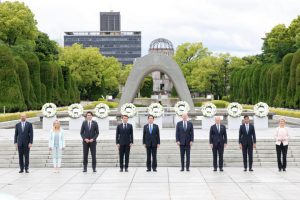Have world leaders learned the horror of the atomic bombing from their historic 40-minute visit to the Peace Museum “behind closed doors?”
May 20, 2023
Japan considers the position of the U.S., the nation that dropped the atomic bomb
by Masanori Wada and Kaori Ota, Staff Writers
How much have world leaders learned about the devastating consequences of the atomic bombing? On May 19, leaders of the G7 (Group of Seven industrialized nations) who are in Hiroshima for the G7 Hiroshima Summit, including the nuclear-weapon states: the United States, the United Kingdom and France, toured Hiroshima Peace Memorial Museum in Peace Memorial Park (Hiroshima’s Naka Ward) for about 40 minutes. Following the museum tour, they offered wreaths of flowers at the Cenotaph for A-bomb Victims, mourning victims who lost their lives in a single atomic bomb dropped 78 years ago. The media, however, was not allowed to enter the museum with the leaders, and the Japanese government has not revealed details of the visit.
At around 10:30 a.m., Ursula von der Leyen, President of the European Commission, was the first to arrive at the park in the rain. Japan’s Prime Minister Fumio Kishida welcomed her with a smile in front of the East Building of the Peace Museum. She was followed by other G7 leaders who arrived and entered the museum one by one. U.S. President Joe Biden appeared last at around 11:20 a.m., and went into the museum with Prime Minister Kishida.
We could not see inside the museum as its windows were sealed with white sheets. Just past noon, nine leaders came out of the same door they used to enter the East Building. The visit lasted about 40 minutes. U.S. President Biden gently put his hand on the shoulder of Prime Minister Kishida walking beside him.
According to Japan’s Ministry of Foreign Affairs, they received explanations of some exhibits from Prime Minister Kishida, and spoke with Keiko Ogura, 85, Naka Ward, an A-bomb survivor. She shared the story of Sadako Sasaki, a young girl who continued folding paper cranes on her sickbed and became the inspiration for the Children’s Peace Monument. However, details of the museum visit have not been released.
The G7 leaders walked the central approach in the park, where the rain had stopped, laid wreaths of flowers at the Cenotaph for the A-bomb Victims and observed a silent prayer. Then, a commemorative photograph was taken with the Atomic Bomb Dome in the background, which was unlike the usual Summit photographs in that they were not smiling.
“I wonder how much time they spent to see the exhibits. Did they really need to seal the windows?” Toshiyuki Mimaki, 81, the chair of the Hiroshima Prefectural Confederation of A-bomb Sufferers Organizations, mentioned his dissatisfaction in an interview with the press. Under tight security, the tour of the museum was conducted “behind closed doors,” with Japan showing consideration for the United States, which dropped the atomic bomb. When Takuo Takigawa, Director of the Peace Memorial Museum, was asked in an interview about what the G7 leaders saw in the museum, he had to repeat the same words: “It was a part of a national event and I am not at liberty to answer that question. Please ask the government.”
At night, Prime Minister Kishida explained to the press at the Grand Prince Hotel Hiroshima (Minami Ward), the main venue of the Hiroshima Summit, that “it was decided not to disclose the content of their visit to the museum during the process of preparation and adjustment.”
(Originally published on May 20, 2023)








